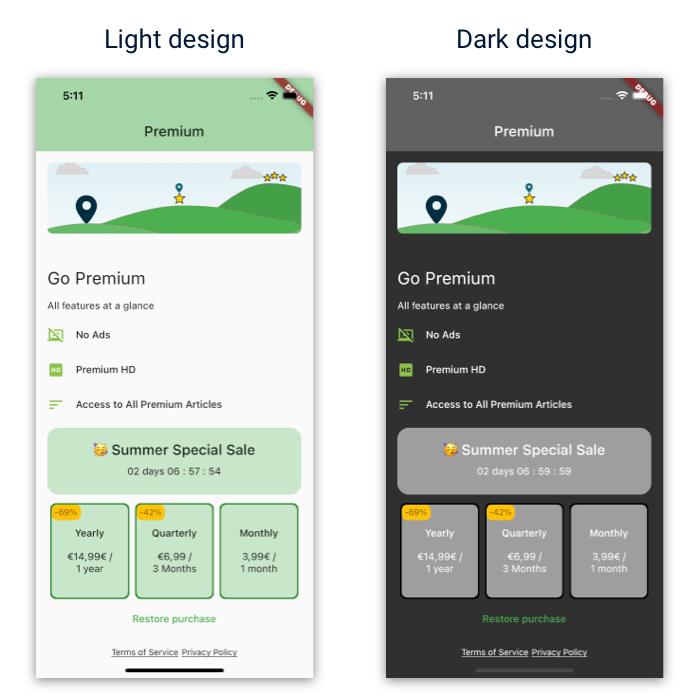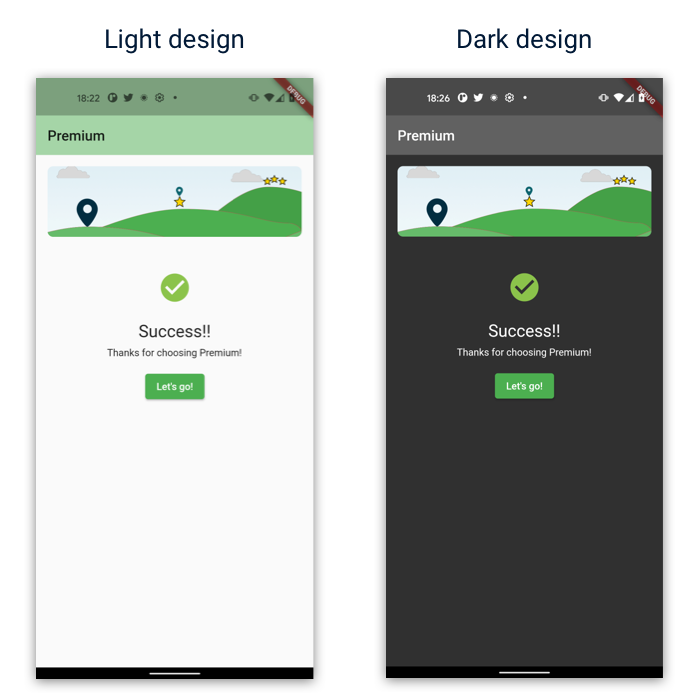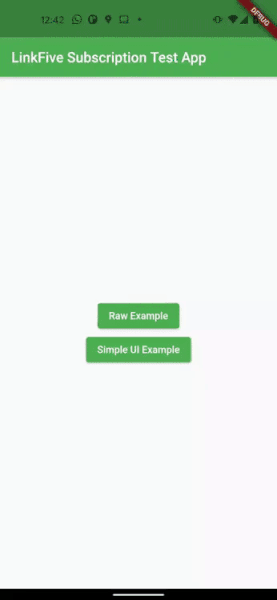linkfive_purchases 4.0.1  linkfive_purchases: ^4.0.1 copied to clipboard
linkfive_purchases: ^4.0.1 copied to clipboard
Manage your in-app subscriptions with the LinkFive plugin - The Easiest Implementation of Subscriptions.
In-app purchases and subscription management for Flutter #
This document provides a comprehensive overview of the LinkFive Purchases Flutter library, allowing you to integrate in-app purchases and subscription management functionalities into your Flutter application.
What is LinkFive Purchases? #
LinkFive Purchases empowers developers to seamlessly implement and manage in-app purchases and subscriptions within their Flutter applications. It simplifies the integration process, taking care of the complexities and streamlining the experience for both developers and users.
Getting Started #
- Sign Up and Obtain API Key: Visit the LinkFive website (https://app.linkfive.io/sign-up) to register and acquire your unique API key (it's free!). This key is essential for initializing the LinkFive Purchases plugin within your application.
- Installation: Add the
linkfive_purchasespackage to your pubspec.yaml file and runpub getto download and install the necessary dependencies.
Core Functionalities #
Supported Purchase Types:
- Subscriptions: Offer recurring billing plans that provide users with ongoing access to premium features or content within your app.
- One-Time Purchases: Enable users to purchase a product or service permanently with a single payment.
Initialization:
- Employ the
initmethod to initialize the LinkFive Purchases plugin, providing your API key as an argument. You can optionally set the logging level using thelogLevelparameter.
await LinkFivePurchases.init("API_KEY");
Fetching Products:
- Utilize the
fetchProductsmethod to retrieve a list of available products from LinkFive. This method is crucial for populating your paywall or displaying relevant subscription options to users.
await LinkFivePurchases.fetchProducts();
Purchasing Products:
- Trigger the purchase flow for a specific product using the
purchasemethod. This method takes aProductDetailsobject as input, representing the product the user intends to purchase.
await LinkFivePurchases.purchase(productDetails);
- BETA-function: In version 4.x we also added
purchaseFuturewhich will wait for the purchase to finish and return the ActiveProducts.
await LinkFivePurchases.purchaseFuture(productDetails);
Restoring Purchases:
- The
restoremethod enables users to restore previously purchased products. This ensures continued access to subscribed features upon app reinstallation or device change.
await LinkFivePurchases.restore();
- BETA-function: In version 4.x we also added
restoreFuturewhich will wait for the restore to finish and return the ActiveProducts.
await LinkFivePurchases.restoreFuture();
Products Stream:
- The
productsstream continuously delivers information about the user's offering. Whenever the user opens the paywall, you want to show the data that is included in this stream.
stream = LinkFivePurchases.products.listen((products) {
// Handle products here
});
Active Products Stream:
- The
activeProductsstream continuously delivers information about the user's active and verified products. This stream proves valuable for managing access to subscription-based features or One-time purchases within your application.
stream = LinkFivePurchases.activeProducts.listen((activeProducts) {
// Handle active products here
});
Purchase in Progress Stream #
The purchaseInProgressStream provides real-time updates on the purchase process. This stream is helpful for displaying loading indicators or disabling purchase buttons while a purchase is underway.
An example riverpod Notifier would be:
/// true -> show loading indicator / disable purchase button
/// false -> disable loading indicator / enable purchase Button
class PremiumPurchaseInProgressNotifier extends Notifier<bool> {
@override
bool build() {
final streamSub =
ref.read(billingRepositoryProvider).purchaseInProgressStream().listen((bool isPurchaseInProgress) {
state = isPurchaseInProgress;
});
ref.onDispose(() {
streamSub.cancel();
});
return false;
}
}
Subscription and One-Time Purchase Offerings #
A typical riverpod notifier implementation would be:
class PremiumOfferNotifier extends Notifier<LinkFiveProducts?> {
/// fetched once whenever the user enters the paywall
Future<void> fetchOffering() async {
state = await ref.read(billingRepositoryProvider).fetchOffering();
}
void purchase(LinkFiveProductDetails productDetails) {
ref.read(billingRepositoryProvider).purchase(productDetails.productDetails);
}
void restore() {
ref.read(billingRepositoryProvider).restore();
}
@override
LinkFiveProducts? build() {
return null;
}
}
And the Widget Implementation:
class _PurchasePaywall extends ConsumerWidget {
@override
Widget build(BuildContext context, WidgetRef ref) {
final premiumOffer = ref.watch(premiumOfferProvider);
if (premiumOffer == null) {
// return Page Loading Widget
}
return ListView(children: [
for (final offer in premiumOffer.productDetailList)
switch (offer.productType) {
LinkFiveProductType.OneTimePurchase => LayoutBuilder(builder: (_, _) {
// build your One Time Purchase Widget
// e.g:
// Text(offer.oneTimePurchasePrice.formattedPrice)
// and later when pressed:
// onPressed: () {
// ref.read(premiumOfferProvider.notifier).purchase(offer);
// }
}),
LinkFiveProductType.Subscription => LayoutBuilder(builder: (_, _) {
// build your Subscription Purchase Widget
// use the pricing Phases:
// for (var pricingPhase in offer.pricingPhases) {
// Text(pricingPhase.formattedPrice);
// Text(pricingPhase.billingPeriod.iso8601); // e.g.: P6M
// }
// and later when pressed:
// onPressed: () {
// ref.read(premiumOfferProvider.notifier).purchase(offer);
// }
}),
}
]
);
}
}
Active & Purchased Products #
A typical riverpod notifier implementation would look like this:
class PremiumPurchaseNotifier extends Notifier<bool?> {
Future<void> _initBilling() async {
final activeProducts = await ref.read(billingRepositoryProvider).load();
state = activeProducts.isNotEmpty;
print("Billing initialized $state");
}
@override
bool? build() {
_initBilling();
final purchaseStream = ref.read(billingRepositoryProvider).purchaseStream().listen((LinkFiveActiveProducts event) {
print("Purchase Update $event");
state = event.isNotEmpty;
});
ref.onDispose(() {
purchaseStream.cancel();
});
return null;
}
}
LinkFiveActiveProducts holds all active purchases, Subscriptions and One-Time Purchases.
// LinkFiveActiveProducts
activeProducts.planList;
activeProducts.oneTimePurchaseList;
Wrap LinkFive into a repository for testing #
You can wrap the Purchases implementation inside a Repository pattern or use it directly.
final billingRepositoryProvider = Provider<BillingRepository>((ref) => LinkFiveBillingRepository());
class LinkFiveBillingRepository extends BillingRepository {
@override
Future<LinkFiveActiveProducts> load() async {
return LinkFivePurchases.init(
LinkFiveKey().apiKey,
logLevel: LinkFiveLogLevel.DEBUG,
);
}
@override
Future<LinkFiveProducts?> fetchOffering() {
return LinkFivePurchases.fetchProducts();
}
@override
Future<LinkFiveActiveProducts> loadActiveProducts() async {
return LinkFivePurchases.reloadActivePlans();
}
@override
void purchase(ProductDetails productDetails) async {
await LinkFivePurchases.purchase(productDetails);
}
@override
Future<void> restore() async {
await LinkFivePurchases.restore();
}
Stream<LinkFiveActiveProducts> listenToPurchases() {
return LinkFivePurchases.activeProducts;
}
@override
Stream<LinkFiveActiveProducts> purchaseStream() {
return LinkFivePurchases.activeProducts;
}
@override
Stream<bool> purchaseInProgressStream() {
return LinkFivePurchases.purchaseInProgressStream;
}
}
ProductDetails, Pricing Phase & Google‘s new Base Plans approach #
Google changed how they handle subscriptions and added Base Plans & PricingPhases to it's new data model. Unfortunately, the in_app_purchase library exposes different models depending on the platform.
We decided to combine the ProductDetails class into a simple to use class called LinkFiveProductDetails which holds pricingPhases for both platforms, Android & iOS.
class LinkFiveProductDetails {
/// Platform dependent Product Details such as GooglePlayProductDetails or AppStoreProductDetails
final ProductDetails productDetails;
/// Base64 encoded attributes which you can define on LinkFive
final String? attributes;
/// Converts the new Google Play & AppStore Model to a known list of pricing phases
List<PricingPhase> get pricingPhases;
}
Pricing Phase #
The PricingPhase class now holds all information about the product and it's phases. An example would be a FreeTrial phase and a yearly subscription as 2 elements in the PricingPhase list.
Here are all interesting parts of the class:
class PricingPhase {
/// Represents a pricing phase, describing how a user pays at a point in time.
int get billingCycleCount;
/// Billing period for which the given price applies, specified in ISO 8601 format.
Period get billingPeriod;
/// Returns formatted price for the payment cycle, including its currency sign.
String get formattedPrice;
/// Returns the price for the payment cycle in micro-units, where 1,000,000
/// micro-units equal one unit of the currency.
int get priceAmountMicros;
/// ISO 4217 e.g. EUR, USD
String get priceCurrencyCode;
/// Recurrence of the phase
Recurrence get recurrence;
}
Period & PeriodUnit class #
The Period class now holds the length of a subscription.
class Period {
final int amount;
final PeriodUnit periodUnit;
}
enum PeriodUnit {
DAYS('D'),
WEEKS('W'),
MONTH('M'),
YEARS('Y');
}
A Period of 3 months would be Period(amount: 3, periodUnit: MONTH) and a year would be Period(amount: 1, periodUnit: YEAR),
From the Period class to a readable user-friendly text
We added a intl-localization-package which uses the intl package that can help you translate the Period into a readable text.
Here is the package on pub.dev
You can use the isoCode from the billingPeriod to get a readable String:
final translationClass = pricingPhase.billingPeriod.iso8601.fromIso8601(PaywallL10NHelper.of(context));
The translation class will output:
7 daysfromP7D1 monthfromP1M3 monthsfromP3M(or alsoquarterly)1 yearfromP1Y(or alsoyearly)
You can submit your own translation to it's github Repository.
Easy Integration with the Paywall UI package #
Integrate linkfive_purchases with package in_app_purchases_paywall_ui.
- it's working with just passing the LinkFive client to the UI library
- Automatic purchase state management
- The UI is fully customizable
- You can control the UI on our Website
Purchase Page #

Success Page #

Page State Management #

That‘s it. Now the page will automatically offer the subscriptions to the user or if the user already bought the subscription, the paywall will show the success page.